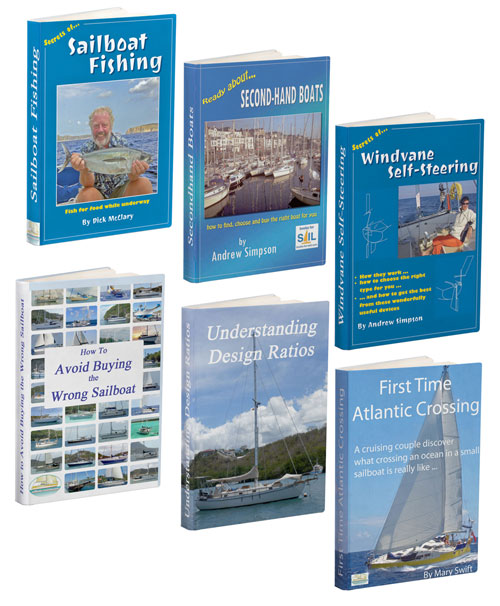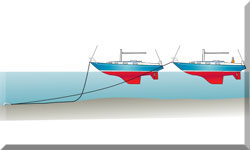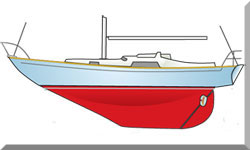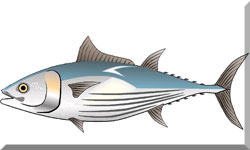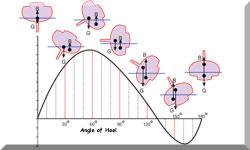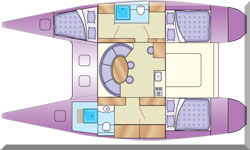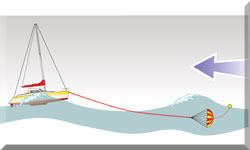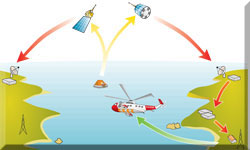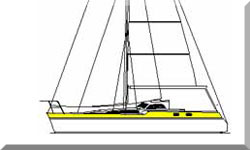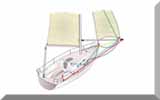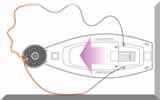- Home
- Electronics & Instrumentation
- Sailboat Autopilot
- Multihull Autopilot
Multihull Autopilots: They're Not Your Average Electronic Helmsman
So, you're a proud owner of a sailing multihull – a sleek catamaran slicing through the waves or a trimaran with its distinctive grace. You know these boats aren't like your average monohulls, and when it comes to choosing an autopilot, the same holds true.
While the fundamental goal of keeping you on course remains, there are some distinct considerations that come into play when selecting an electronic helmsman for your multi-hulled beauty. Let's dive into what makes multihull autopilot selection a little different for these fantastic vessels.
 Pretty quick, I would imagine...
Pretty quick, I would imagine...First off, get ready for speed! Multihulls, especially those designed for performance, are like the sports cars of the sailing world. They leap forward in a puff of wind and can quickly hit speeds that would leave a monohull in their wake. This rapid acceleration and the quick shifts in the apparent wind angle that come with it mean your autopilot needs to be sharp.
It's not enough for it to react slowly; it needs a fast processing speed and a lightning-quick response time to keep you tracking straight. Imagine a hesitant driver trying to keep a sports car in its lane during rapid acceleration – that's what a sluggish autopilot would be doing on your multihull, likely leading to frustrating oscillations and deviations from your intended path.
Then there's the way multihulls dance with the waves. Unlike monohulls that tend to lean into a swell, multihulls generally experience less of that rolling motion. However, they can have a quicker, almost jerky response to waves, especially in a good chop.
Your autopilot needs to be smart enough to differentiate between a genuine change in course and just the boat's natural motion in the seaway. If it overreacts to every little wiggle, you'll end up with an uncomfortable ride and your batteries will be working overtime. This is where advanced algorithms come into play – they can filter out those rapid, less significant movements while still being alert to real course changes.
Now, let's talk about the wind. Multihulls are incredibly sensitive to the apparent wind. As you pick up speed, that apparent wind swings forward dramatically, and when the breeze drops, it can swing aft just as quickly. A good autopilot for a multihull should be able to steer to a consistent apparent wind angle (AWA), especially when you're enjoying a fast reach.
This can be a real game-changer for efficient sailing. However, just like with speed changes, these rapid shifts in AWA demand a responsive autopilot that can keep up. Some manufacturers even offer specific "multihull modes" or settings in their autopilots, fine-tuning the system to handle these unique wind dynamics.
The very structure of many multihulls also presents unique considerations, particularly when it comes to steering. Catamarans, with their wider beam, can have different leverage and forces acting on the steering system compared to a slender monohull.
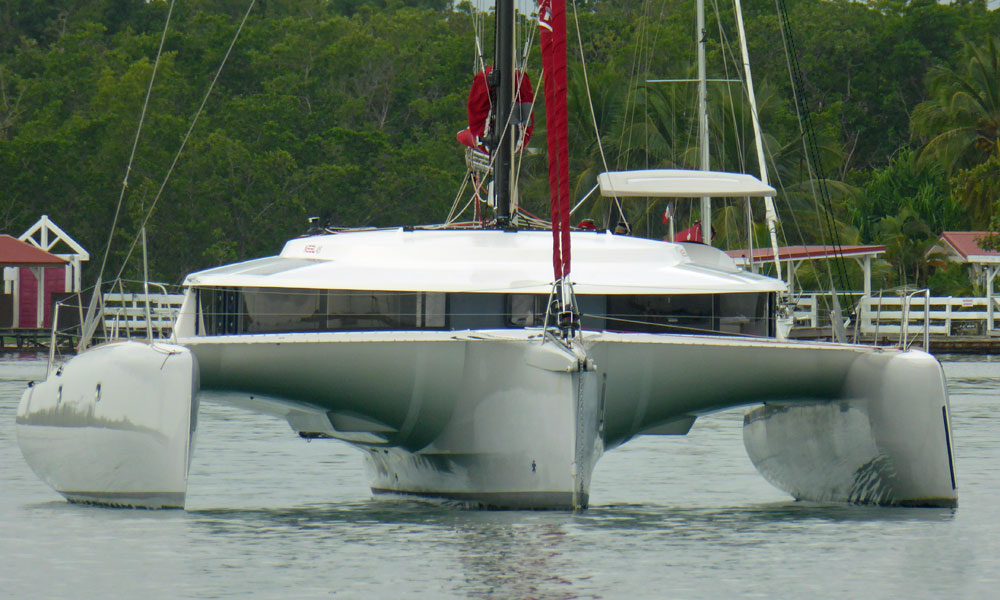 On passage to Guadeloupe, this Neel 45 overtook my 38ft monohull like I was drifting under bare poles...
On passage to Guadeloupe, this Neel 45 overtook my 38ft monohull like I was drifting under bare poles...Plus, many multihulls sport dual rudders, offering excellent control but requiring the autopilot to manage both in perfect harmony. You'll need to think about the type of steering linkage connecting those rudders and how the autopilot's drive unit will interface with it to ensure smooth and coordinated steering.
Weight is always a concern on a boat, but it can be particularly critical on multihulls, especially keeping weight out of the bows and sterns to avoid pitching. So, opting for a lightweight and efficient autopilot system becomes even more important to maintain your multihull's performance and agility. Every saved kilogram contributes to better handling and speed.
What about going old school with a windvane? While these purely mechanical self-steering systems are popular for long offshore passages on monohulls, the jury's out on their universal suitability for catamarans.
Some argue that the responsiveness of multihulls to apparent wind and the complexities of setting up a windvane to effectively handle the wider hull and potentially dual rudders in all conditions can make electronic autopilots a more practical choice. That being said, some adventurous multihull owners do successfully use windvanes, especially when power conservation is the absolute priority for extended cruising. However, I suspect that that is likely to have been said by the owner of a multihull of a more pedestrian nature.
Finally, let's not forget about the juice! Keeping those batteries topped up is crucial on any sailing vessel, and the faster response and potentially more frequent corrections an autopilot might make on a lively multihull could lead to higher power consumption. Choosing an efficient autopilot system designed for the demands of a multihull will help you conserve those precious amp-hours, especially on longer trips.
In a nutshell, when you're choosing an autopilot for your catamaran or trimaran, you'll want to prioritize things like fast processing and response, smart algorithms that understand multihull motion, the ability to steer effectively to apparent wind angles, compatibility with your specific rudder setup, light weight, and efficient power usage.
Thankfully, the leading names in marine autopilots – think Raymarine, Garmin, B&G, and Simrad – offer systems that are well-equipped to handle the unique characteristics of sailing multihulls, often with dedicated settings or modes to optimize their performance.
The key is to choose a system that's robust and responsive enough to handle the speed and agility of your multi-hulled dream machine.
Tiller-Steered Multihulls
While tiller-steered multihulls might seem like a straightforward match for standard tiller pilots, their unique characteristics – faster speeds, different motion, and sensitivity to apparent wind – mean you'll want to consider models that can handle these demands effectively.
Here are some suggestions, keeping those factors in mind...
Response Speed and Processing Power:
- Simrad TP32: This model is often recommended for larger tiller-steered boats and is known for its more powerful drive and faster response compared to entry-level models like the TP10. Its ability to interface with NMEA 0183 allows for connection to wind instruments and GPS for more advanced steering modes, which can be beneficial for multihull sailing. Some users on forums have specifically mentioned the TP32 as a faster option suitable for multihulls.
- Raymarine EV-100 Tiller: Being part of Raymarine's Evolution series, this pilot utilizes their intelligent EV-1 sensor core. This advanced sensor is designed to adapt to changing sea conditions and vessel dynamics, which could be advantageous for the quicker movements of a multihull. While typically recommended up to around 6,000 kg (13,200 lbs) displacement, ensure your multihull falls within this range when fully loaded.
- The Pelagic Autopilot: While not a mainstream brand like Raymarine or Simrad, the Pelagic Autopilot is a well-regarded option for many tiller-steered multihulls due to its robust design, sophisticated gyro-based steering, and positive track record among offshore sailors.
System Integration and Advanced Features:
- Simrad TP22 & TP32 (with NMEA 0183): As mentioned, the ability to interface with wind and GPS data is crucial for efficient multihull sailing. These Simrad models offer this connectivity, allowing you to steer to a specific wind angle or follow GPS waypoints, which can be particularly useful on longer passages or when trying to maintain optimal speeds.
- Raymarine ST2000+ (with SeaTalk/NMEA): While an older model, the ST2000+ can also interface with other instruments. If your multihull isn't overly large or performance-oriented, this could be a more budget-friendly option to gain some of these integrated features.
Important Considerations Specific to Tiller-Steered Multihulls:
- Thrust Rating: Multihulls, even if relatively light, can generate significant forces on the tiller at higher speeds. Ensure the tiller pilot you choose has a sufficient thrust rating to handle these loads without being overworked.
- Stroke Length: Check the stroke length of the tiller pilot to ensure it provides adequate rudder movement for effective steering on your multihull. Some multihulls might require a greater range of tiller movement for tacking or maneuvering.
- Mounting: Consider the geometry of your multihull's cockpit and tiller. Ensure there's a suitable location for the tiller pilot mounting socket that allows for a direct and efficient connection to the tiller.
- Power Consumption: While all autopilots draw power, consider the efficiency of the unit, especially if you plan on extended use under autopilot on your multihull.
It's crucial to:
- Accurately assess your multihull's fully laden displacement. Don't rely on the designed displacement, as added gear can significantly increase the weight.
- Consider the typical sailing conditions you encounter. If you frequently sail in strong winds and large waves, a more powerful and responsive pilot will be necessary.
- Read reviews and forums from other multihull owners who have used tiller pilots. Their real-world experiences can provide valuable insights.
While the options for tiller pilots specifically marketed for multihulls might be fewer than wheel pilots, the key is to choose a robust model with sufficient thrust, a fast enough response rate, and ideally, the ability to integrate with other navigation instruments to take advantage of features like wind and GPS steering.
Always prioritize safety and ensure the chosen autopilot is well within its recommended specifications for your boat.
Wheel Steered Multihulls
It's true that wheel-steered multihulls present a unique set of demands for autopilots. Here are some suggestions for wheel pilots that are well-equipped to handle their specific characteristics:
Prioritizing Fast Response and Advanced Algorithms:
- Raymarine Evolution EV-100 Wheel Pilot: This system is specifically highlighted by Raymarine as suitable for wheel-steered sailboats up to 7,500 kg (around 16,500 lbs) displacement. Its key advantage for multihulls lies in its intelligent EV-1 sensor core. This 9-axis sensor utilizes aerospace-derived technology to monitor the boat's motion in all three dimensions and adapt to changing sea conditions and vessel dynamics. This "Evolution Ai" aims to provide precise and confident course keeping, which is crucial for the faster speeds and potentially more abrupt movements of a multihull. It's also designed for relatively easy DIY installation.
- Garmin Reactor 40 with Wheel Drive: Garmin's Reactor 40 series is known for its responsive performance, which is a significant plus for multihulls. When paired with their wheel drive unit, it offers a robust solution. The Reactor 40 boasts solid-state 9-axis AHRS technology, similar to Raymarine's Evolution, allowing it to react quickly and minimize heading error, even in dynamic conditions. Its seamless integration with Garmin chartplotters is also a strong point for those within the Garmin ecosystem.
Powerful Drive Units and Robustness
- Raymarine Cockpit MkII Wheel Drive: This drive unit is a more heavy-duty option from Raymarine, also rated for sailboats up to 7,500 kg displacement. Its robust construction and adjustable clutch lever suggest it's built to handle potentially higher loads and more demanding conditions that a multihull might experience. Paired with an appropriate Actuator Control Unit (ACU) and Evolution sensor, this could be a reliable choice.
- B&G Autopilot Systems with a Wheel Drive: While B&G's focus is often on integrated, high-performance systems, they do offer autopilot computers like the NAC-2 that can be paired with a wheel drive unit (often sourced within the Navico group, which includes Simrad). B&G autopilots are known for their sophisticated sailing algorithms, including wind steering capabilities, which can be very beneficial for multihulls sensitive to apparent wind. You'd typically pair the NAC-2 with a B&G control head like the Triton² Pilot.
Key Considerations for Wheel-Steered Multihulls
- Accurate Displacement: As with tiller pilots, always consider your multihull's fully laden displacement, which can be significantly higher than its designed weight. Choose a pilot rated well above this figure for reliable performance.
- Drive Unit Strength: Multihulls can generate significant steering forces, especially at higher speeds or in strong winds. Ensure the wheel drive unit has sufficient torque to handle these loads without slipping or being overworked.
- Integration with Instruments: Given the importance of apparent wind on multihulls, look for autopilots that can readily integrate with your wind instruments via NMEA 2000 or SeaTalkNG. This will unlock valuable features like steering to a constant wind angle. Integration with GPS is also crucial for track following.
- Specific Multihull Modes/Settings: Some autopilots may offer specific "multihull modes" in their software. These modes are often tuned to better handle the faster speeds and unique motion characteristics of these boats. Check the manufacturer's specifications and user reviews for mentions of such features.
- User Reviews from Multihull Owners: The best real-world feedback will come from other multihull sailors who have experience with specific autopilot models. Search online forums and owner groups for their recommendations and any potential issues they've encountered.
In summary, for wheel-steered multihulls, you'll want to look for autopilots that offer:
- Fast and responsive steering algorithms;
- Robust wheel drive units with sufficient torque;
- Seamless integration with wind and GPS instruments;
- Potentially, specific multihull operating modes;
- A displacement rating that comfortably exceeds your boat's fully loaded weight.
By keeping these unique characteristics in mind, you can select a wheel pilot that will provide reliable and efficient steering for your sailing multihull, enhancing your enjoyment and safety on the water.
.........................
I wrote this article using GPT-4, OpenAI’s large-scale language-generation model, as a research assistant to gather information, summarize research findings, and provide suggestions for the content and structure of the article.
Dick McClary, creator and owner of sailboat-cruising.com
.........................
Recent Articles
-
Multihull Autopilot Selection is Not Straightforward
Apr 19, 25 01:25 PM
Whether its for a catamaran or a trimaran, tiller or wheel steered, a multi hull autopilot must be endowed with specific performance characteristics... -
Wheel-Steering Autopilots: Your Questions Answered...
Apr 18, 25 03:45 PM
Whatever your question, you should find the answer here -
Tiller Pilots: Your Questions Answered...
Apr 18, 25 08:18 AM
Got a question about sailboat tiller pilots? Odds are, you'll find the answer here
